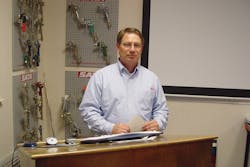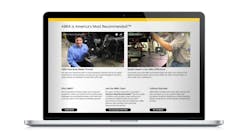Because SATA has been helping European shops transition to waterborne for the past five years, the company and its employees have gained expertise and insight on what shops need—and don’t need—to ease the transition to waterborne. As the training director, Steve Treutel works with the labs, training centers and field reps of all the major paint companies to develop educational programs. At the company’s training center in Minnesota, he sees as many as 300 students a year, and another 3,000 painters are trained at evening clinics taught by the team of SATA field reps throughout the country. Here, Treutel shares his insights into what the switch to waterborne may mean for shops—and for their painting equipment.
We’re approaching the deadline in California for shops to complete the transition to waterborne. What’s setting successful shops apart?
Shops that remove the old standby solvent systems and make a complete changeover to waterborne paints are doing better from the start than those who still try to use their solvent system for difficult colors and tough jobs.
In most cases, paint company technicians are training their customers in how to spray their waterborne base coats. This works well. But when a painter doesn’t get this training, then we see problems with dry times, metallic control, contamination and color match.
What products and equipment help shops make the move from solvent-based to waterborne paint?
It all starts with the quality and volume of spray air. A three-stage filter that removes water and oil droplets, oil vapors, and dirt, and then allows up to 129cfm through at 90psi, or with 70cfm, is ideal. The best filters sift particles down to .01 micron and also have a third-stage charcoal filter to stop oil vapors. At that point, you’re spraying with air that’s clean enough to safely breathe.
Spray guns are next on the list. You want one that won’t corrode in water and that has been tested by all paint companies to deliver the proper amount of material. Of course, you would still need the proper nozzle set-up in these guns, following the recommendations of your paint company.
Disposable cups are nice to have since waterborne paints don’t clean up all that well.
A small, portable air blower/dryer—preferably on a stand to make the most of your work space—provides extra air movement to dry the paint.
Nongassing spray hoses prevent contamination.
And then there is the question of safety: A paint suit and supplied-air respirator is a must.
What are the similarities between spray technology for solvent-based paints and waterborne paints?
Because SATA has always worked closely with the paint companies as they’ve developed new products, there haven’t been any major changes in spray technology associated with waterborne paint. It still all comes down to atomizing the paint: You’re looking to put a certain amount of paint on the panel in a certain amount of time, and you want it to dry at a certain rate.
What’s different about using high-volume/low-pressure (HVLP) vs. reduced pressure (RP) spray guns with waterborne paints?
Again, there are no significant differences. If you have the correct nozzle set up according to the paint company then there is no difference in spraying. With that being said, you would notice a difference if your shop has low air volume. In that case, an RP gun, which sprays 30 percent less cfm than HVLP guns, would be the better choice.
Why are the HVLP and RP spray guns better for the environment?
Old high-pressure spray guns had only a 25 to 35 percent transfer efficiency, whereas newer SATA models of HVLP and RP guns have a rate well over 65 percent. That means less waste, as paint is delivered more efficiently.
What should all shops know about caring for their spray equipment?
Your spray equipment is only as good as you take care of it. I’ve heard painter after painter say that their spray equipment sprayed really well when it was new, but complained about how performance declined over time. But give that painter’s spray gun a full cleaning, and he’s happy again. Why not clean your gun after each use?


